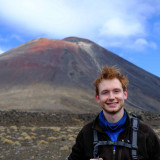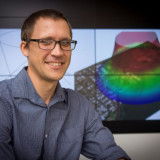Mapping CO2 Outgassing Over Volcanic Regions Using Hyperspectral Imaging
Presentation
Authors: Daniel Sturgess, Nitin Bhatia, Gabor Kereszturi, Stuart Mead, Agnes Mazot
Event: Geosciences 2023 (NZ)
Summary: CO₂ detection methods using airborne and satellite hyperspectral scenes of Tongariro (New Zealand) and Ambae (Vanuatu), inspecting point source and diffuse CO₂ emissions.
Magmatic degassing is often the main driving force of volcanic eruptions and governs whether they are effusive or explosive, exsolving from the magma as it rises. Elevated CO₂ flux from a volcano can indicate the movement of magma deep in the system, displaying a potential eruption precursor, demonstrated by recent eruptions including Te Maari (2012), Villarrica (2015) and Stromboli (2019). Active degassing can further induce hydrothermal alteration of primary volcanic lithologies, due to magmatic heat and (acidic) fluids passing through permeability zones. Studying these aspects of volcanic activity improves our understanding of their relationships and allows for the development of multi-dimensional maps and models that can contribute to hazard mitigation efforts.
Hyperspectral remote sensing presents a unique opportunity to explore both volcanic outgassing and associated hydrothermal alteration. CO₂ spectral absorption features are present in the SWIR region of the electromagnetic spectrum at 1.4–1.6 µm and 1.9–2.0 µm, these signatures can be used to detect pixelwise CO₂ emissions and estimate atmospheric columnar abundance. We present CO₂ detection methods that exploit gas absorption features in the 1.9–2.0 µm wavelengths of airborne and satellite hyperspectral scenes of Tongariro (New Zealand) and Ambae (Vanuatu), inspecting point source and diffuse CO₂ emissions.
To validate our methods, we used mineral spectral library data and MODTRAN atmospheric modelling to generate synthetic radiance data where ground truth CO₂ values are pre-set, simulating the spectral signals of typical volcanic/hydrothermal environments. We use this synthetic data to conduct sensitivity analyses, investigating the influence of atmospheric water vapour, aerosol content, surface albedo and mineral absorption features on measuring CO₂. The mapped CO₂ emission and sources are discussed and integrated with existing geophysical techniques such as aeromagnetic datasets to detail the connection between surface signatures and hydrothermal alteration depth.

Daniel Sturgess
PhD Student

Gabor Kereszturi
Earth Scientist

Stuart Mead
Earth Scientist